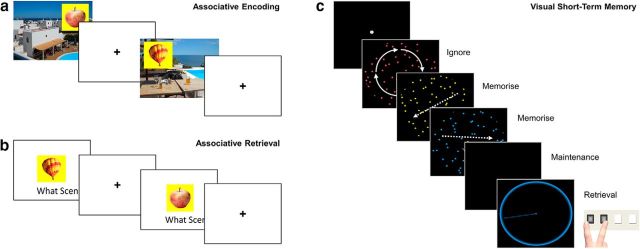Figure 1.
Memory tasks. a, b, LTM task. c, STM task. a, Associative encoding. In the scanned study phase of the LTM task, participants were asked to make up a story that linked each object with its background scene (120 trials total). A scene with positive valence is illustrated. On each trial, the scene was presented for 2 s, the object was superimposed for 7.5 s, and finally the screen was blanked for 0.5 s before the next trial. b, Associative retrieval. At test (out of the scanner), each object was presented again and, after a measure of priming, item memory, and background valence memory, participants were asked to verbally describe the scene with which it was paired at study. The latter verbal recall was scored as correct or incorrect, which was then used to classify the trials at study into “remembered” and “forgotten” (see text for details). The example illustrates encoding and retrieval of a trial with neutral valence. c, An example trial of STM task with memory load of two items. Trials began with fixation dot for 7 s. On each trial, three dot displays were displayed in red, yellow, and blue for 500 ms each (250 ms gap). To vary load, the dots in one, two, or three of the dot displays moved in a consistent direction (the to-be-ignored displays rotated). After the last display, the screen was blanked for an 8 s maintenance period and then the probe display presented a colored circle to indicate which dot display to recall (red, yellow, or blue). Participants had up to 5 s to adjust the pointer until the direction matched that of the to-be-remembered display.

